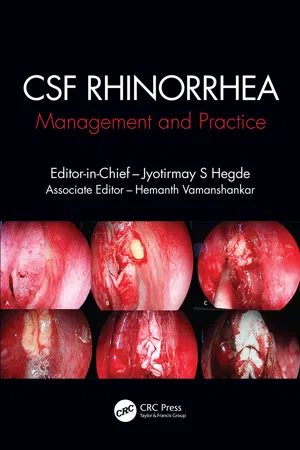
CSF Rhinorrhoea
Management and Practice
Jyotirmay S. Hegde, Hemanth Vamanshankar, Jyotirmay S. Hegde, Hemanth Vamanshankar
- 136 páginas
- English
- ePUB (apto para móviles)
- Disponible en iOS y Android
CSF Rhinorrhoea
Management and Practice
Jyotirmay S. Hegde, Hemanth Vamanshankar, Jyotirmay S. Hegde, Hemanth Vamanshankar
Información del libro
Cerebrospinal fluid (CSF) rhinorrhea is a rare but potentially devastating condition that can lead to significant morbidity and mortality. CSF Rhinorrhea: Management and Practice covers the current concepts in the etiology, diagnosis, and treatment of the condition, as well as long-term management of patients following successful treatment. It provides broad insight into the causes for leakage of CSF from the nose and helps in diagnosis and subsequent treatment. Its multidimensional approach caters to medical undergraduates and postgraduates along with specialists in various fields such as ENT, neurosurgery, neurology, medicine and endocrinology, thus providing a comprehensive plan for management of CSF rhinorrhea.
Key features
- Focuses on trans-nasal endoscopic repair of CSF rhinorrhea
-
- Explores minimally invasive techniques and recent advances in CSF rhinorrhea
-
- Reviews clinical presentation and case diagnosis with special emphasis pertaining to general practitioners
-
- Discusses post-operative care in an exclusive chapter
-
- Includes videos of surgical procedures
Dr Jyotirmay S Hegde is currently a consultant ENT, head and neck and endoscopic skull base surgeon at Columbia Asia Hospital, Whitefield, Bangalore, India. He has also worked as a faculty member in various capacities at the Jawaharlal Institute of Postgraduate Medical Education & Research (JIPMER), Pondicherry, India. Dr Hegde completed his Masters in Otolaryngology-Head & Neck Surgery at Karnataka Institute of Medical Sciences, Hubli, Karnataka, India and his Fellowship in Rhinology and Endoscopic skull base surgery from Aintree University Hospital, Liverpool, UK. Dr Hegde is a fellow of the European Board of Otolaryngology (FEBORL). He has published in several peer-reviewed scientific publications and presented in national and international conferences, courses, and workshops.
Dr Hemanth Vamanshankar graduated from K.S.Hegde Medical Academy, Mangalore, India in 2008 and completed a diploma in Otolaryngology from St John's Medical College, Bangalore, India in 2011 and DNB-ENT from Southern Railway Hospital, Ayanavaram, Chennai, India in 2014. He was awarded MRCS-ENT from the Royal College of Surgeons, Edinburgh, UK. He has to his credit 25 indexed publications of national and international repute. He is currently working as a medical officer and consultant ENT surgeon at the Divisional Railway Hospital, Bangalore, India (South Western Railway).
Preguntas frecuentes
Información
1
History of CSF rhinorrhea


References
- 1. Thomson St. C. The Cerebro-Spinal Fluid: Its Spontaneous Escape from the Nose. London, UK: Cassell & Co., Ltd., 1899, p. 8.
- 2. Thomson S and Negus VE. Diseases of the Nose and Throat (5th edition). New York: Appleton-Century-Crofts, Inc., 1947, p. 104.
- 3. Chiari H. Ueber einen Fall von Luftansammlung in den Ventrikeln des menschlichen Gehirns. Ztschr f Heilk 5:383, 1884.
- 4. Luckett WH. Air in the ventricle of the brain following fracture of the skull. Surgery, Gynecology & Obstetrics 17:237, 1913.
- 5. Dandy WE. Pneumocephalus (Internal pneumocele or aeroscele). Archives of Surgery 12:949–982, 1926.
- 6. Dohlman G. Spontaneous cerebrospinal rhinorrhea. Acta Otorrinolaringologica 67:20–23, 1948.
- 7. Grant FC. Intracranial aerocele following a fracture of the skull. Surgery, Gynecology & Obstetrics 36:251, 1923.
- 8. Lanza DC, O'Brien DA and Kennedy DW. Endoscopic repair of cerebrospinal fluid fistulae and encephaloceles. Laryngoscope 106:1119–1125, 1996.
- 9. Vrabec DP, Hallberg OE. Cerebrospinal fluid rhinorrhea. Archives of Otolaryngology 80:218–229, 1964.
- 10. Wigand WE. Transnasal ethmoidectomy under endoscopic control. Rhinology 19:7–15, 1981.
- 11. Cushing H. Experiences with orbito-ethmoidal osteomata having intracranial complications, with the report of four cases, Surgery, Gynecology & Obstetrics 44:721–742, 1927.
- 12. McKinney R. Traumatic pneumocephalus. The Annals of Otology, Rhinology, and Laryngology 41:597–600, 1932.
- 13. Cairns H. Injuries of the frontal and ethmoidal sinuses with special reference to cerebro-spinal rhinorrhoea and aeroceles. The Journal of Laryngology an...